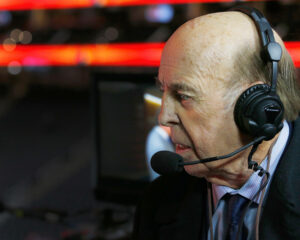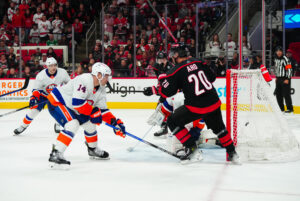Vancouver Canucks GM Jim Benning lack of action has made the one thing clear: it’s going to be very hard to move the dreadful Loui Eriksson contract. This is especially true if he wants to move Eriksson this year.
But is it impossible?
Breaking Down the Loui Eriksson Contract
The Big Year
In 2016 there were a half dozen good Unrestricted Free Agents who had a history of strong, skilled play. It was an offseason unlike any other, with a ridiculous amount of talent available. All teams had to do was outbid the competition! Suddenly they’d have more scoring (Kyle Okposo), toughness (Milan Lucic), leadership (Andrew Ladd, David Backes), depth (Frans Nielsen) or…
What Could Go Wrong?
Eriksson was a special case. Well known for his defensive responsibility, he also produced 20 or more goals in seven of his ten NHL years up to that point. He wrapped up the 2015-16 season with 30 goals and 33 assists for the Boston Bruins. Perfect timing for the free agent, sure, but there was one extra consideration for Vancouver – his international play.
The line of Daniel Sedin, Henrik Sedin, and Loui Eriksson flat-out worked for Team Sweden in 2016. The twins assisted on Eriksson’s four goals in four games. Their chemistry was obvious. He was available, the Sedins’ scoring was slowing down, and the Canucks had missed the playoffs the year before. If Daniel and Henrik retired, Eriksson was much younger and would continue to be a useful player. If he could bring their numbers back up – even if just for the two years left on their contracts – it would be worth it.
So the Canucks pulled the trigger. They gave Eriksson a very competitive offer, ultimately signing him to a six-year contract with a $6 million cap hit each season. While other teams were clearly in the race for Loui Eriksson, the Canucks had everything in place to reel in the winger.
Declining Values
Despite the high hopes, things seemed to crash and burn for Eriksson. There was an effort made to get that value from his contract. He had every opportunity to reignite that international chemistry; but on a team where the Sedins were the only true offensive threat, they proved easy to counter. The trio would be split up and the desperate team tried him with anyone else to get him going.
Eriksson didn’t provide scoring with anyone else, either, with a career-low shooting percentage and just 24 points in 65 games in his first year with Vancouver. The Canucks had their lowest goal total in team history. The contract that was initially viewed by fans with suspicion was already being judged a failure.
Not a great start given it was a six-year deal.
Eriksson did a little better the next season, sort of, with 23 points in 50 games. Come year three, his points-per-game average dropped again as Head Coach Travis Green moved him to a defensive specialist role. We found out what Eriksson thought about that this offseason, giving rise to speculation he wanted out.
Value vs. Cost of Loui Eriksson’s Contract
While Eriksson’s value has clearly dropped since signing his deal, he isn’t as worthless as some claim.
Even with his lowest ice time since he entered the league, Eriksson scored 11 goals and 18 assists last year. And he got those the long way, with over 60% of his starts in the defensive zone. Given his most frequent linemates were Jay Beagle or Antoine Roussel, his scoring opportunities were limited. Both his Fenwick and Corsi were negative last year for the first time in eight seasons. He was on the right side of takeaways/giveaways (+19) as always. He’s versatile enough to play either wing, as needed.
In short, he’s a perfectly decent fourth line player and defensive specialist. He might produce more points playing with more skilled players – netting nine points in the last 19 games of the season, mostly alongside Bo Horvat, hints at that – but that wouldn’t be why someone traded for him now.
Eriksson is undeniably an NHL player. He has that level of talent. He has skills that teams want – but not ones they pay $6 million for.
The Crux
It is, as always, about the money. Or is it?
Eriksson has already been paid his $4 million signing bonus money due this year. This means he only has $9 million in real money left owing over the next three seasons, including the remaining salary owed to him this upcoming season. While more than ideal, three years with an average pay of $3 million a season is doable, considering Eriksson’s strength as a defensive specialist.
While Vancouver can’t afford to bring a bad contract back in return, they could retain half of his salary, if needed. This would still save the Canucks $3 million in cap space. The cap hit would drop to $3 million the receiving team, as well. The two teams would also split the actual paychecks owed to Eriksson, effectively paying $4.5 million each.
But.
He still has a no-trade clause to work around and has said previously that he is uninterested in waiving it. To change his mind, any team wanting him will likely have to promise a chance to play in a more offensive role. He clearly won’t find that with Vancouver, which could induce him to waive the NTC. Add to that his $6 million cap hit – and the Canucks’ desperation to get out from under it – and the price drops further. Any team getting Eriksson will have his NTC to deal with, and players don’t improve after 34 years old. (Mark Giordano somehow excepted.)
The Pitch
Benning heavily implied that he could send Loui Eriksson to Utica, with the owner’s full consent. He’s done it before, moving Sam Gagner down before a trade for Ryan Spooner. Whether this is an actual threat or not – the team would only save around $1 million, and Eriksson would get the ice time he wants – is slightly beside the point. Any team that might consider taking him wouldn’t want to do so off waivers, where they’d have to pay his full salary. The announcement, if anything, was less to the player and more to the fans and any potential trade partners.
Say what you will about Benning’s trade history, but saying ‘We’re willing to lose $6 million dollars on Loui Eriksson’s contract’ is one hell of a sales pitch.
*Amusingly, the player looked at as the “least” of those aforementioned six free agents, Neilsen, is likely the best signing of all of them. Still too expensive, but he’s managed 109 points in the three years since his signing and is still an effective middle-six player. Lucic has 104, but his skills have atrophied dramatically. Okposo has 118, but is more expensive and has three years to go on his deal. Backes has 91 points, but is well on his way out of Boston. Ladd might bounce back, but he’s going to have to work his way back up the Islanders roster following an ACL injury.
Suddenly contracts worth millions for young RFAs instead of six and seven-year older UFAs make sense, don’t they?
Main Photo:






